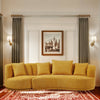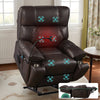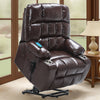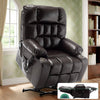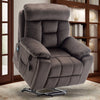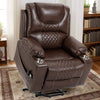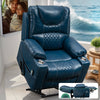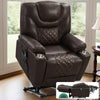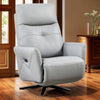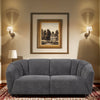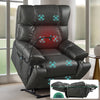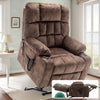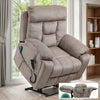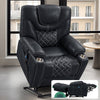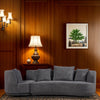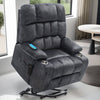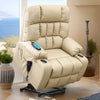Understanding the Benefits of Lift Recliners for the Elderly
The Importance of Mobility in Later Years
As we age, mobility becomes a crucial factor in maintaining quality of life. It affects our ability to perform daily tasks and stay independent. Reduced mobility can lead to social isolation and health issues. Seniors often face challenges with standing up or sitting down. This is where lift recliners come in handy. These chairs provide support and ease of movement. They help seniors maintain their independence and comfort at home. Lift recliners can significantly improve the daily lives of older adults. They offer a blend of comfort, safety, and functionality. By enhancing mobility, these chairs promote a more active and fulfilling lifestyle for seniors.

How Lift Recliners Support Elderly Independence
Lift recliners are more than just comfortable chairs. They are tools for independence. These chairs use a power lift mechanism to tilt forward. This helps seniors stand up with less effort. The same mechanism also assists in sitting down gently. This feature reduces the risk of falls and injuries. Lift recliners often have multiple positions for comfort. Users can adjust the chair for reading, watching TV, or napping. Some models even offer heat and massage features. These extras can help with pain relief and circulation. By providing easy position changes, lift recliners prevent muscle stiffness. They allow seniors to rest and move more freely throughout the day. This independence boosts confidence and overall well-being in older adults.
Choosing the Right Lift Recliner for Your Home
Factors to Consider When Selecting a Lift Recliner
Choosing the right lift recliner is crucial for comfort and functionality. Consider the size of both the user and the room. The chair should fit the user properly and have enough space to recline. Look at the weight capacity to ensure it supports the user safely. The type of controls is important too. Some prefer simple buttons, while others like remote controls. Fabric choice matters for both comfort and maintenance. Leather is easy to clean, while fabric may be cozier. Think about additional features like heat or massage options. These can provide extra comfort for those with chronic pain. The lift mechanism's strength is crucial for smooth operation. Make sure it can handle the user's weight effortlessly. Lastly, consider the warranty and after-sales service. A good warranty can save money on future repairs.

The Role of Comfort and Safety in Lift Recliners
Comfort and safety are top priorities when choosing a lift recliner. A comfortable chair encourages regular use, which is beneficial for health. Look for adequate padding and support in the seat, back, and arms. Adjustable headrests and lumbar support can enhance comfort. Safety features are equally important. Anti-tip mechanisms prevent the chair from tipping forward. Battery backup ensures the chair works during power outages. Some chairs have sensors that stop movement if obstacles are detected. This prevents pinching or trapping. The fabric should be non-slip to keep users secure when seated. Sturdy construction is essential for long-term safety and durability. Easy-to-use controls prevent confusion and frustration. Smooth, quiet operation adds to the overall comfort and safety. Remember, a safe and comfortable chair promotes independence and peace of mind.
Installation and Maintenance of Lift Recliners
Best Practices for Lift Recliner Setup
Proper setup of a lift recliner is key to its performance and longevity. Start by choosing the right location. Ensure there's enough space for full recline and lift functions. Keep the chair away from walls and furniture. This prevents damage and ensures safe operation. Follow the manufacturer's assembly instructions carefully. Some chairs come pre-assembled, while others need some setup. Place the chair on a level surface to prevent rocking or instability. Check all connections and tighten any loose screws. Test the lift and recline functions before regular use. Make sure the power cord is safely tucked away to prevent tripping. If the chair has a battery backup, install it according to instructions. Teach all users how to operate the chair safely. Show them how to use the controls and emergency features. Proper setup ensures the chair works correctly and safely from day one.

Routine Care and Upkeep for Lift Recliners
Regular maintenance keeps lift recliners in top condition. Start with daily cleaning to remove dust and debris. Use a soft brush or vacuum cleaner for fabric surfaces. For leather, wipe with a damp cloth and dry immediately. Check the mechanisms weekly for smooth operation. Listen for unusual noises that might indicate problems. Lubricate moving parts as recommended by the manufacturer. This keeps the lift and recline functions working smoothly. Inspect the power cord regularly for any signs of wear or damage. Replace it if you notice any issues. Clean the controls with a slightly damp cloth to remove dirt and oils. Avoid using harsh chemicals that could damage the chair's materials. Rotate cushions if possible to ensure even wear. Tighten any loose screws or bolts you find during inspections. Regular care prevents major issues and extends the life of your lift recliner.
Troubleshooting Common Issues with Lift Recliners
Even with good care, lift recliners may experience issues. If the chair doesn't lift or recline, check the power connection first. Ensure the chair is plugged in and the outlet works. Check if the battery backup needs replacement. If the movement is jerky, the mechanism might need lubrication. Follow the manual for proper lubrication techniques. Strange noises often indicate loose parts. Tighten any visible screws or bolts. If the fabric is torn, patch it quickly to prevent further damage. For electrical issues, always consult a professional. Never try to repair electrical components yourself. If the remote control fails, try replacing the batteries. Clean the contacts if changing batteries doesn't help. For persistent problems, contact the manufacturer or a certified repair service. Keep the warranty information handy for covered repairs. Regular maintenance can prevent many common issues with lift recliners.







